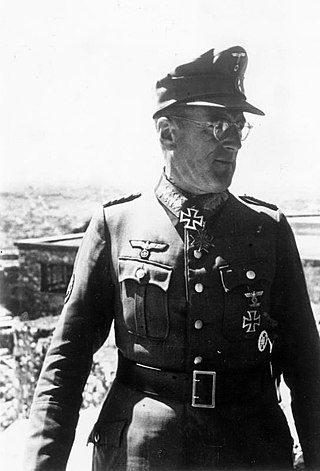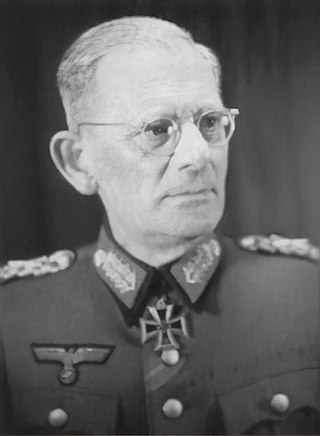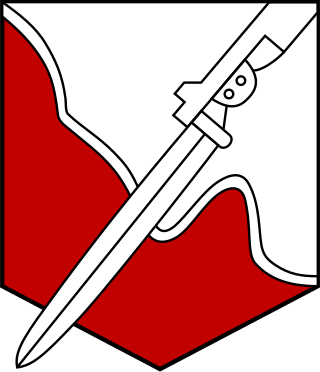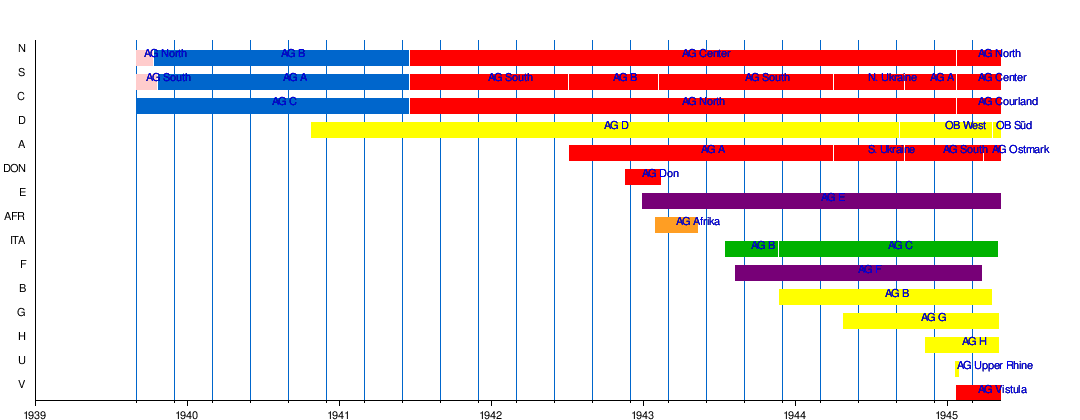
Army Group South was the name of one of three German Army Groups during World War II.

Ferdinand Schörner was a German military commander who held the rank of Generalfeldmarschall in the Wehrmacht of Nazi Germany during World War II. He commanded several army groups and was the last Commander-in-chief of the German Army.

Maximilian Maria Joseph Karl Gabriel Lamoral Reichsfreiherr von und zu Weichs an der Glon was a German Generalfeldmarschall in the Wehrmacht of Nazi Germany during World War II.
An army group is a military organization consisting of several field armies, which is self-sufficient for indefinite periods. It is usually responsible for a particular geographic area. An army group is the largest field organization handled by a single commander – usually a full general or field marshal – and it generally includes between 400,000 and 1,000,000 soldiers.
Army Group Centre was the name of two distinct strategic German Army Groups that fought on the Eastern Front in World War II. The first Army Group Centre was created during the planning of Operation Barbarossa, Germany's invasion of the Soviet Union, as one of the three German Army formations assigned to the invasion.

The 6th Army was a field army of the German Army during World War II. It is widely known for its defeat by and subsequent surrender to the Red Army at the Battle of Stalingrad on 2 February 1943. It committed war crimes at Babi Yar while under the command of Field Marshal Walther von Reichenau during Operation Barbarossa.
Army Group A was the name of three distinct army groups of the Heer, the ground forces of the Wehrmacht, during World War II.
Army Group North was the name of three separate army groups of the Wehrmacht during World War II. Its rear area operations were organized by the Army Group North Rear Area.

The 12th Panzer Division was an armoured division in the German Army, established in 1940.
Army Group B was the name of four distinct German army group commands that saw action during World War II.
Army Group G fought on the Western Front of World War II and was a component of OB West.
Army Group Ostmark was an army group of Nazi Germany. It was formed near the end of World War II and active for just over a month, between 2 April and 8 May 1945. Its sole commander was Lothar Rendulic and its main area of operations was German-controlled Austria.
Army Group South Ukraine was a joint German-Romanian group on the Eastern Front during World War II.

The Uman–Botoșani offensive or Uman–Botoshany offensive was a part of the Dnieper–Carpathian offensive, carried out by the Red Army in the western Ukrainian Soviet Socialist Republic against the German 8th Army of Army Group South during World War II. Led by Marshal of the Soviet Union Ivan Konev, it became one of the most successful Red Army operations of the whole war. In over a month of combat through the deep spring mud and numerous water barriers, the 2nd Ukrainian Front advanced over 300 kilometres (190 mi), cleared German forces from southwestern Ukraine, and entered Romania and Moldova.

The Zhytomyr–Berdychiv offensive operation was a part of the strategic offensive of the Red Army in the right-bank (western) Ukrainian SSR, the Dnieper–Carpathian offensive. The successful offensive operation was conducted by the forces of the 1st Ukrainian Front commanded by General of Army Nikolai Vatutin during World War II, from 24 December through to 14 January 1944.

The 93rd Infantry Division was a German infantry division that was formed in the fall of 1939. The division fought in the Second World War in both the Battle of France and on the Eastern Front. It was ultimately destroyed by the Red Army in March 1945 while defending East Prussia.

The 31st Infantry Division was a German infantry division of the Army during World War II. It participated in the invasion of Poland in 1939 then the invasion of France and the Low Countries in 1940. As part of Panzergruppe 2. of Army Group Centre, it was involved in the invasion of the Soviet Union in June 1941. After hard fighting throughout 1941 and 1942 it joined the 9th Army and fought in the Battle of Kursk in July and August 1943. Along with the rest of the 9th Army, the division conducted a fighting withdrawal for the remainder of 1943, during which it sustained heavy casualties. In the early stages of the Soviet Operation Bagration of June to August 1944, the 31st Infantry Division was destroyed, a fate which subsequently befell most of Army Group Centre. The division was officially disbanded on 18 July 1944.
The 454th Security Division was a rear-security division in the Wehrmacht of Nazi Germany. The unit was deployed in German-occupied areas of the Soviet Union, in the Army Group South Rear Area.
Armeegruppe was a historical type of major formation of German military history, in use in the Imperial German Army during World War I and the Wehrmacht during World War II.









